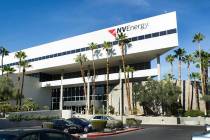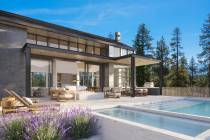Saving greenbacks by going green
Green, more than a color, is a catchall term used to describe an ecoconscious lifestyle, including everything from hybrid-fuel-powered cars to recycled consumer goods to solar electricity. The big-minded concept is to preserve the Earth's natural resources by reducing waste and pollution through innovative design and improved efficiency. In development circles, green has gone from a boutique idea to a mandatory part of architecture and construction.
"It's not just about energy savings," said Craig Willcut, president of United Construction, which opened new sustainable offices in Reno this year. "It's about providing a healthy environment for employees, as well as being socially responsible for our part of the environment."
Companies with green offices have an easier time recruiting and retaining employees, studies show. Healthy work settings, with plenty of daylight and fresh air, can reduce sick days. Today's Generation Y work force actively seeks social-minded employers that reduce their carbon footprints and improve the world around them.
"It's a popular thing with the younger generation," said Christopher Larson, spokesman for the Sustainable Development Committee of the Las Vegas chapter of NAIOP, a commercial real estate trade group. "They want to work for a company that is thinking sustainable because it's cool and the right thing to do."
Buildings are responsible for 40 percent of the Earth's global warming, observers say.
"Corporate responsibility is becoming unavoidable," said Rick Van Diepen, chairman of the Committee on the Environment for the Las Vegas chapter of the American Institute of Architects. "Employee productivity is being improved by 1 percent to 2 percent, conservatively, by working in a green building. That is a huge bottom-line savings."
Companies and municipalities, for example, are turning to four-day workweeks with 10-hour workdays. This schedule cuts driving, thereby cutting fossil fuel emissions, while decreasing consumption of water and electricity. Some businesses have started car pool and recycling programs for employees. Others use glues, carpets and paints free of volatile organic compounds.
"The utilization of green cleaning standards and green products are good for the environment, the tenants and often times, the bottom line," said Susan Wincn, president of the Building Owners and Managers Association of Nevada. "We work to provide education and best practices to reduce the use of natural resources, nonrenewable energy and waste production."
Some steps toward becoming green are as simple. Businesses can use drought-tolerant landscaping or low-flow plumbing fixtures to save water. Building with recycled wood, steel and glass is convenient, cheap and environmentally sound.
"Costs for building green are going down," said J.F. Finn III, a principal with Gensler of Nevada, executive architect for MGM Mirage's $8.5 billion CityCenter development. "Companies now have more experience building green, so there are greater efficiencies."
The country's hottest green building program today is called Leadership in Energy and Environmental Design, or LEED. It's a rating system created by the U.S. Green Building Council in 2000 that grades project sustainability based on points awarded for water conservation, energy efficiency and environmental quality, among other things. The more points, the higher the rating, which goes from basic certification up to Silver, Gold and Platinum.
Companies increasingly use LEED certification as branding; it's now a part of corporate marketing and identity. LEED-certified buildings command higher rents, observers say. Operating costs account for 35 percent to 50 percent of office rents, yet energy bills can vary up to $1 per square foot among similar buildings just a few feet apart.
"It's clear that the building with the lowest operating costs will have more options when negotiating with tenants," said B. Alan Whitson, a national authority on facility design and management and CEO of Newport Beach, Calif.-based B. Alan Whitson Co. "Turning green can cut energy costs by 40 percent or more, and upgrading a building's lighting can add $6 per square foot to its value."
Although Nevada only has about two dozen LEED-certified projects thus far, 166 more developments are preregistered for future certification. All new federal and state buildings are required to be designed to Silver LEED standards. Assembly Bill 3, signed into law in 2005, also gives tax breaks for LEED-certified projects.
It runs around $2,500 to file the paperwork. Building costs, meanwhile, can add up to 2 percent of the project's overall cost. It's a negligible amount since most building projects have a 5 percent contingency factored into their budgets.
"If a project is approached with the right mindset early on, green buildings should not cost extra," said Deepika Padam, president of the Las Vegas chapter of the U.S. Green Building Council. "The LEED-certified level should become the future typical building."
Contact reporter Tony Illia at tonyillia@aol.com or 702-303-5699.

















